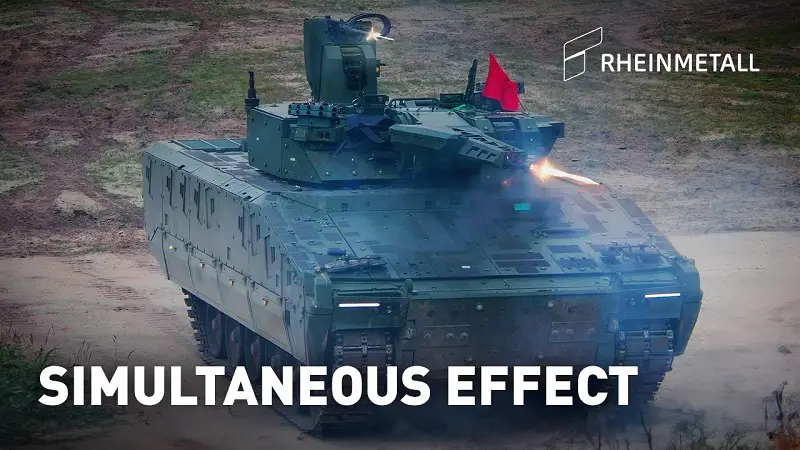Rheinmetall‘s Lynx infantry fighting vehicle (IFV) is engaging targets downrange with pin-point accuracy in an undisclosed location. Demonstrating its delay-free killer-killer capability, both 30mm Mk30-2 machine cannon and Main Sensor Slaved Armament (MSSA) with a .50 heavy machine gun are providing effect simultaneously on independent targets. The MSSA facilitates the engagement of targets especially at high elevation in close range, such as Unmanned Aerial Vehicles (UAVs) and shooters on roof tops. If the commander operates his reconnaissance systems to assist the gunner in target acquisition, the Lynx fulfils “hunter-killer” functionality. But when the MSSA comes into play, the commander is able to individually engage targets with the secondary weapon while the gunner operates the main armament against other targets at the same time, the Lynx takes on doubly-powerful “killer-killer” capabilities. With the optional Main Sensor Slaved Armament (MSSA) the Lynx KF41 gains additional advantage in close-combat environments.

The Line of Fire (LoF) of this secondary weapon is able to follow the commander’s Line of Sight (LoS) and is stabilised in elevation and azimuth axes. The MSSA can be fitted with machine guns of different calibres or a 40-mm Grenade Machine Gun (GMG) to enable engagement of secondary targets independently of the primary weapon. The MSSA can also be fitted with a range of other less-than-lethal and non-lethal weapons. Another optional weapon system is the Anti Tank Guided Missile (ATGM) launcher capable of firing Spike LR missiles. In most IFVs, vibration causes loaded ATGMs to deteriorate, meaning they have to be loaded just prior to firing. The Lynx allows greater preparedness through a vibration damper allowing ATGMs to be loaded further in advance. The flexible mission pod on the Lance 2.0 turret can be fitted with a variety of other subsystems for specific requirements, including an electronic warfare capability and non-line-of-sight strike loitering munitions. The crew can even launch a UAV from the vehicle to gain invaluable surveillance information for the crew and mission commanders.

The Lynx infantry fighting vehicle is fitted with the updated Lance 2.0 turret, this having flexible mission pods fitted on the left and right sides so that a variety of subsystems can be installed to provide the turret with specialist capabilities. The gas-operated MK30-2/ABM automatic cannon can fire single rounds as well as bursts of 200 rounds a minute. Technically the MK30-2/ABM is capable to fire up to 600 rounds per minute, but for the application in an IFV, the rate of fire is limited, also for the sake of the lifetime of the weapon. Though the MK30-2/ABM makes no compromises, neither in lethality, nor in endurance. Operational flexibility is ensured with a “next round, new type” ammunition feed philosophy – the weapon can fire two different ammunition types to allow selectively lethal effects. The optimum combination of high firing rate and modern airburst ammunition technology makes the MK30-2/ABM an uncompromising weapon system and sets new standards in terms of durability, reliability, technical maturity and precision. It delivers high combat effectiveness against ground and aerial targets up to a distance of 3,000 metres.

In addition to the main armament, the Lynx’s IFV configuration features the latest Rheinmetall Machine Gun (RMG) 7.62 mm, which can fire standard 7.62 × 51 mm NATO ammunition and has a maximum rate of fire of 800 rounds a minute. The commander and the gunner are able to control and fire the co-axial MG via the same interface as the primary weapon, providing fast and flowing weapons switching depending on the specific requirements of the engagement. A light machine gun is mounted co-axially with the main armament, and a RWS armed with a 12.7 mm heavy machine gun is installed on the rear of the turret roof behind the commander’s panoramic sight. A row of eight Wegmann 76 mm smoke dischargers is also installed on either side of the turret behind the two hatches. To ensure best protection of the crew and highest combat strength of the system, the commander of the task force has the opportunity to swap protection packages also in the theatre prior to mission only supported by field service personnel and equipment.













